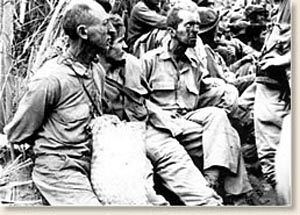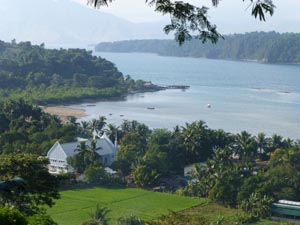One of the reasons I prefer to base myself in the Philippines during the winter months, rather than in the other countries of Southeast Asia, is because Americans and Filipinos share such a meaningful history together. While our own schools may not teach this anymore, the Philippines has not forgotten how we battled side-by-side, with thousands dying together, while fighting off the Japanese invasion of the Philippines during World War 2. The Philippines is rich with American history. There are monuments all around the country. I have had scores of conversations with Filipinos who know the history much better than I do. General Douglas MacArthur remains as one of the greatest heroes in this country.
An American friend of mine, Alfred, and I took a drive down to Bataan a few days ago. That is Bataan, as in the “Bataan Death March,” which began on 12 April, 1942. My understanding of the history is that we were not able to hold off the Japanese invasion because there was no replenishment of supplies and reinforcements. This was because the Japanese took out our Pacific fleet in Hawaii. After months of fighting against overwhelming odds, we finally surrendered to the Japanese army on the 9th of April, 1942. I borrowed this image and the following bit of history From here: The Bataan Death March, 1942 It is not a pretty story. But it is a lesson about how bad things can get, with America still winning the day in the end:
“The war came to the Philippines the same day it came to Hawaii and in the same manner – a surprise air attack. In the case of the Philippines, however, this initial strike was followed by a full-scale invasion of the main island of Luzon three days later. By early January, the American and Filipino defenders were forced to retreat to a slim defensive position on the island’s western Bataan Peninsula. The American and Filipino forces fought from an untenable position until formally surrendering to the Japanese on April 9. The Japanese immediately began to march some 76,000 prisoners (12,000 Americans, the remainder Filipinos) northward into captivity along a route of death. When three American officers escaped a year later, the world learned of the unspeakable atrocities suffered along the 60-mile journey that became known as the Bataan Death March.
Japanese butchery, disease, exposure to the blazing sun, lack of food, and lack of water took the lives of approximately 5,200 Americans along the way. Many prisoners were bayoneted, shot, beheaded or just left to die on the side of the road. “A Japanese soldier took my canteen, gave the water to a horse, and threw the canteen away,” reported one escapee. “The stronger were not permitted to help the weaker. We then would hear shots behind us.”
There is plenty about this part of American history on the Internet. It must have been pure hell for the American and Filipinos that gave their lives for freedom in Bataan. Here is a survivor’s personal account of the ordeal: A Survivor’s Story I warn you in advance that it is not for the lighthearted!
Albert and I drove right down to the western Bataan Peninsula where months of brutal fighting and the final surrender took place. It is all overgrown with jungle now, but there are heightened overviews that show the whole area. You would never even know that such a major battle took place there with so many Americans and Filipinos losing their lives. Albert has spent a lot of time on his own searching the area and says the ground is rich with artifacts. He says it is a treasure hunter’s dream. For me, I only needed to re-tune my frequency a little bit to feel the impact from the months of bombing and shelling, to hear the screams of the wounded and dying, to feel the helplessness and ultimate surrender. Albert says the 300 officers who negotiated the surrender were machine gunned down by their captors. It must have been an overwhelming heartbreak. That’s an understatement!
While reading about our losses in Bataan, we should all be inspired and reminded that no matter how bad things can get, there always remains hope that we can come back and win the day. It’s not over until it is over! While we are going through difficult times in America, we have come back from much worse situations. Maybe we just need to give it some more time.
As Albert and I drove around the area, I was feeling awestruck that we fought and lost such a heated battle there; in a place that now is such a place of beauty. I captured this photo over a nice community down on the water. It’s a tranquil fishing village, probably not much different than it was before 1942. Though they now have modern comforts, things don’t change much in this country. Albert has spent time down there, says he is still disappointed that he didn’t buy a lot that was available right on the water just a few years ago. He says everyone in that village is appreciative of America. I have found that to be true everywhere in this country. But Alfred says it is more so in this hallowed place. Filipinos have not forgotten how great Americans can be when we raise ourselves to it! Just wait; our time will come again!
If difficulty in breathing persists, contact your physician immediately. Decreased high density lipoproteins (HDL) occurred in 40% of subjects. This drug may also be used to help protect the kidneys from damage due to diabetes https://farmaciasonline.org/. National smallpox vaccine in pregnancy registry.
One Response to “How About Some Inspiration?!”
Sorry, the comment form is closed at this time.

This article is a stark reminder that in war, the object is to WIN! Not just gain the upper-hand or to show them who’s boss, but to do whatever it takes to defeat your opponent. There is no 2nd place in war. Unfortunately during wartime, the dark side of human nature turns people into monsters and a Bataan Death March results. Very tragic indeed.